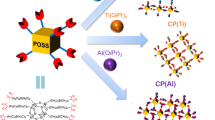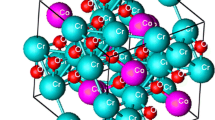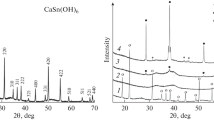Abstract
Powders of SrTiO3 were prepared by the Pechini-type polymerized complex technique, wherein a mixed solution of citric acid (CA), ethylene glycol (EG), Sr and Ti ions with a molar ratio of CA/EG/Sr/Ti = 10/40/1/1 was polymerized at 130°C to produce a yellowish transparent polyester-type resin without undergoing precipitation, which after decomposition on heating at 350°C was used as a powder precursor for SrTiO3. The formation of pure perovskite SrTiO3 practically free from carbonates occurred when the powder precursor was heat treated at temperatures higher than 500°C in static air. No X-ray diffraction and Raman spectroscopic evidence for phase separation of crystalline SrCO3 and TiO2 as distinct intermediates has been obtained during the thermal decomposition of the powder precursor, suggesting the molecular-scale mixing of cations in the Sr-Ti powder precursor. 13C-NMR spectroscopic measurements have indicated that unusual alkoxylation of CA occurred exclusively when both strontium and titanium ions in equal amounts coexist in CA/EG solutions, the phenomenon of which was discussed in connection with possible formation of a Sr-Ti heterometallic CA complex. The number of CA participating in formation of (Sr, Ti)-CAn was estimated to be n ∼ 3 from the variation of 13C-NMR spectra with relative concentrations of metal ions and CA. This heterometallic complex was thermally stable in CA/EG solutions upon heating at 130°C, implying that the molecular-level homogeneity achieved in the Sr/Ti precursor solution was preserved throughout the polymerization process.
Similar content being viewed by others
References
T. Watanabe, A. Fujishima, and K. Honda, Bull. Chem. Soc. Jpn. 49, 355 (1976).
U. Balachandran and N.G. Eror, J. Solid State Chem. 39, 351 (1981).
I. Bunn and S. Neirman, J. Mater. Sci. 17, 3510 (1982).
B. Odekirk, U. Balachandran, N.G. Eror, and J.S. Blakemore, Mater. Res. Bull. 17, 199 (1982).
D.P. Partlow and J. Greggi, J. Mater. Res. 2, 595 (1987).
R. Wernicke, Grain boundary phenomenon in electronic ceramics, in Advances in Ceramics, edited by L.M. Levinson (Am. Ceram. Soc. Columbus, Ohio, 1981), Vol. 1. p. 261.
H. Tagawa and K. Igarashi, J. Am. Ceram. Soc. 69, 310 (1986).
J.S. Smith, R.D. Dolloff, and K.S. Mazdiyanni, J. Am. Ceram. Soc. 53, 91 (1970).
R.E. Riman, R.R. Landham, and H.K. Bowen, J. Am. Ceram. Soc. 72, 821 (1989).
U. Selvaraj, A.V. Prasadarao, S. Komarneni, and R. Roy, Mater. Lett. 12, 311 (1991).
H.K. Varma, P. Krishna Pillai, T. Veettil Mani, K.G.K. Warrier, and A.D. Damodaran, J. Am. Ceram. Soc. 77, 129 (1994).
H.K. Varma, P. Krishna Pillai, M.M. Sreekumar, K.G.K. Warrier, and A.D. Damodaran, Br. Ceram. Trans. J. 90, 189 (1991).
P.K. Gallagher, F. Schrey, and F.V. Dimarcello, J. Am. Ceram. Soc. 46, 359 (1963).
F. Schrey, J. Am. Ceram. Soc. 48, 401 (1965).
G. Pfaff, F. Schmidt, W. Ludwig, and A. Feltz, J. Thermal Anal. 33, 77 (1988).
W. Fam and L. Niinistö, Mater. Res. Bull. 29, 451 (1994).
S. Bhattacharjee, M.K. Paria, and H.S. Maiti, Ceram. Int. 18, 295 (1995).
M.M. Lencka and R.E. Riman, Ferroelectronics 151, 159 (1994).
K.D. Budd and D.A. Payne, Better ceramics through chemistry I, in Materials Research Society Symposium Proceedings, edited by C.U. Brinker, D.E. Clatk, and D.R. Ulrich (Elsevier, Pittsburgh, PA, 1984), Vol. 32, p. 239.
S.G. Cho, P.F. Johnson, and R.A. Condrate, Sr., J. Mater. Sci. 25, 4738 (1990).
E.R. Leite, C.M.G. Sousa, E. Longo, and J.A. Varela, Ceram. Int. 21, 143 (1995).
E.R. Leite, J.A. Varela, E. Longo, and C.A. Paskocimas, Ceram. Int. 21, 153 (1995).
M.P. Pechini, U.S. Patent No. 3,330,697, July 1967.
N.H. Chan, R.K. Sharma, and D.M. Smyth, J. Electrochem. Soc. 128, 1762 (1981).
M. Kakihana, J. Sol Gel Sci. Tech. 6, 7 (1996).
M. Kakihana, M. Arima, M. Yashima, M. Yoshimura, Y. Nakamura, H. Mazaki, and H. Yasuoka, Sol-gel science and technology, in Ceramic Transactions, edited by E.J. Pope, S. Sakka, and L. Klein (Am. Ceram. Soc., Westerville, Ohio, 1995), Vol. 55, p. 65.
M. Arima, M. Kakihana, Y. Nakamura, M. Yashima, and M. Yoshimura, J. Am. Ceram. Soc. 79, 2847 (1996).
K. Nakamoto, Infrared and Raman Spectra of Inorganic and Coordinate Compounds, 4th edition (Wiley, New York, 1986).
J.T. Last, Phys. Rev. 105, 1740 (1957).
M. Kakihana, M. Yashima, M. Yoshimura, L. Börjesson, and M. Käll, Trends in Appl. Spectroscopy 1, 261 (1993).
T. Furukawa and W.B. White, Phys. Chem. Glasses 20, 69 (1979).
U. Balachandran and N.G. Eror, J. Solid State Chem. 42, 276 (1982).
L.F. Johnson and W.C. Jankowski, Carbon-13 NMR Spectra (John Wiley & Sons, Inc. New York, 1972).
M.L. Martin, G.J. Martin, and J.-J. Delpuech, Practical NMR Spectroscopy (Heyden & Son Ltd., London, 1980).
T. Fujita, Chemical and Pharmaceutical Bulletin 30, 3461 (1982).
J. Strouse, S.W. Layten, and C.E. Strouse, J. Am. Chem. Soc. 99, 562 (1977).
The integrated intensities of the 91 ppm and 77 ppm features relative to those of the 46 ppm feature associated with —CH2—of CA increase and decrease linearly, respectively, with increasing metal concentration.
Author information
Authors and Affiliations
Rights and permissions
About this article
Cite this article
Kakihana, M., Okubo, T., Arima, M. et al. Polymerized Complex Route to the Synthesis of Pure SrTiO3 at Reduced Temperatures: Implication for Formation of Sr-Ti Heterometallic Citric Acid Complex. Journal of Sol-Gel Science and Technology 12, 95–109 (1998). https://doi.org/10.1023/A:1008613312025
Issue Date:
DOI: https://doi.org/10.1023/A:1008613312025




